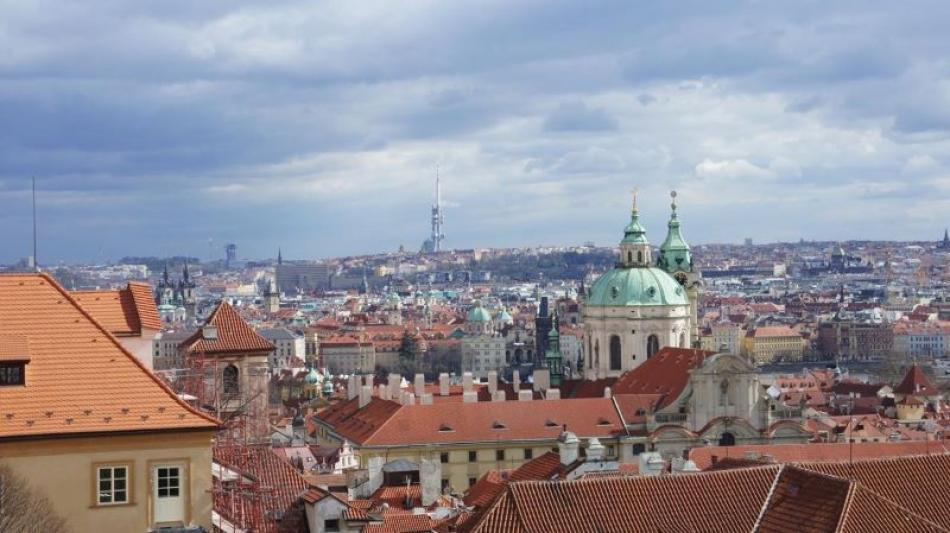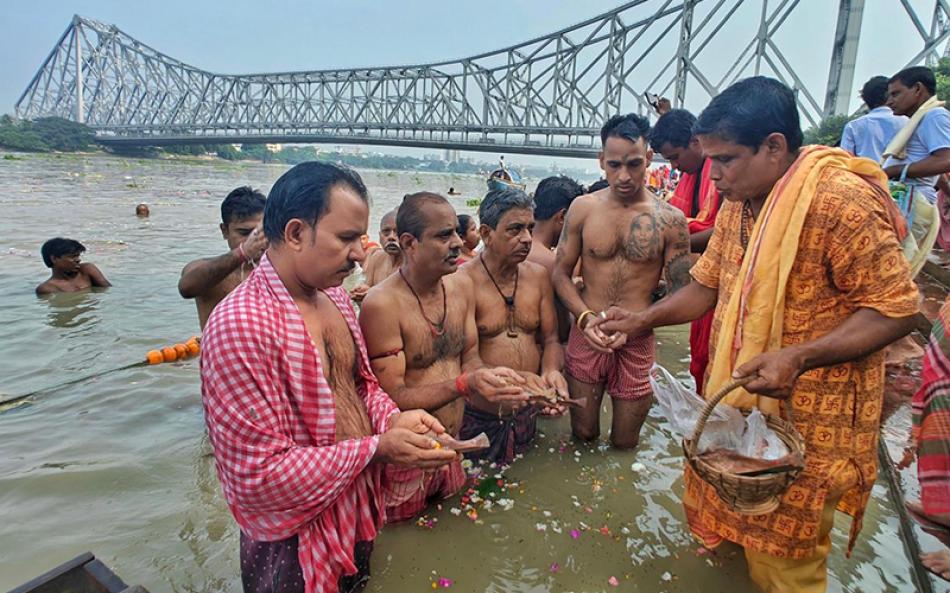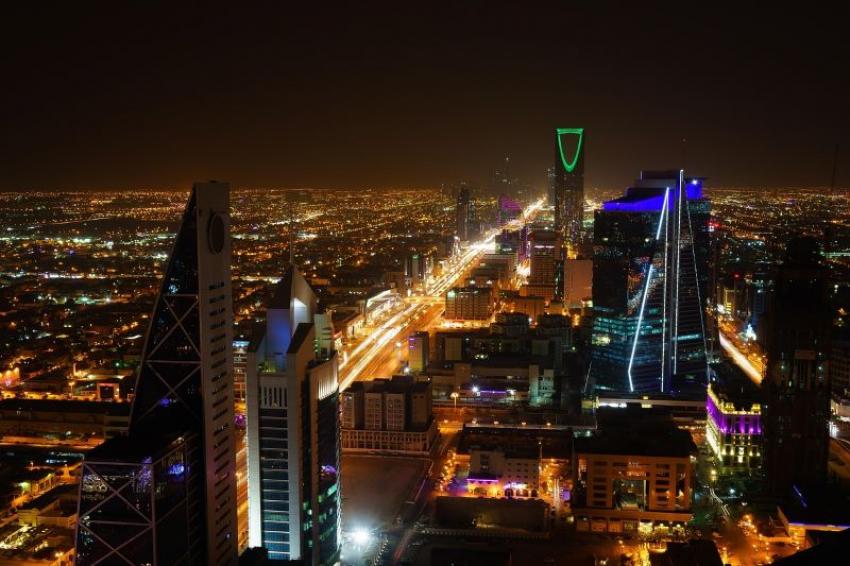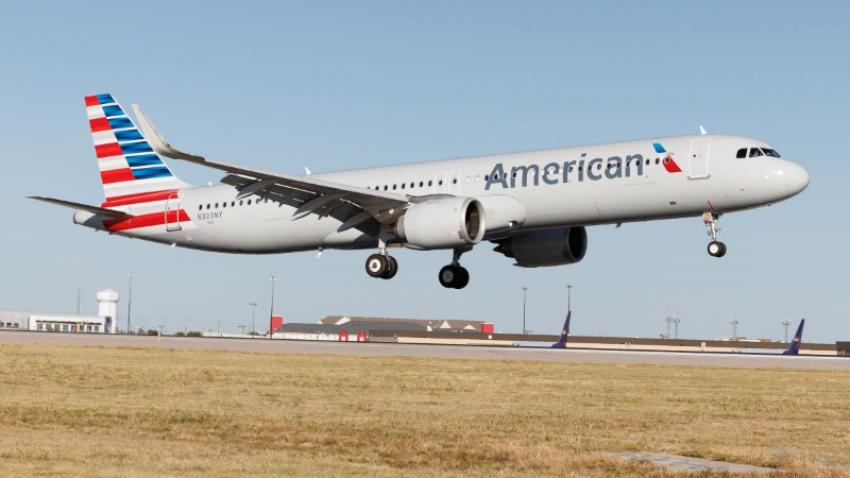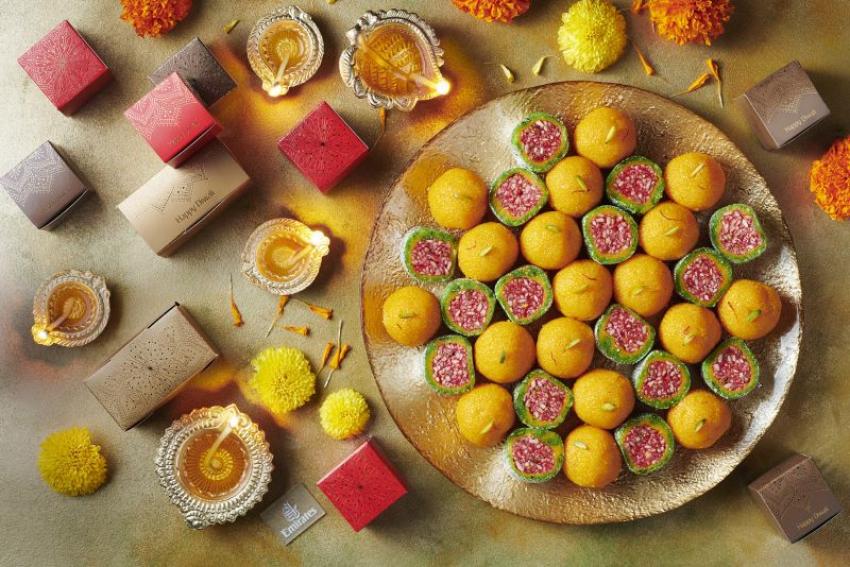NITN | @notintownlive | 24 May 2025, 12:33 am
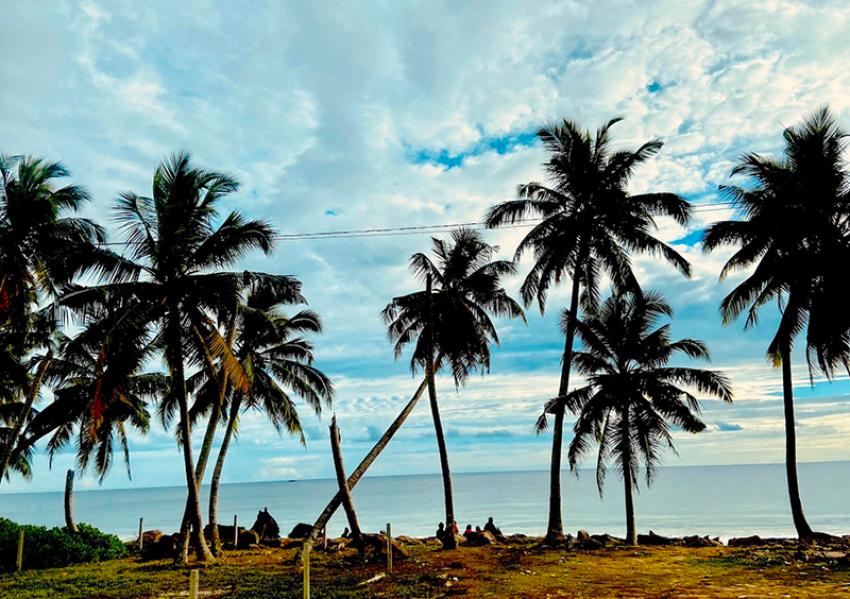 Sri Lanka
Sri Lanka
Sri Lanka is a yearlong destination now. Photo: Sujoy Dhar
Uttara Gangopadhyay writes why Indian travelers should seriously consider Sri Lanka for the tourist season till November and follow an itinerary that combines culture, nature, wildlife and more
For many years, to most travellers, Sri Lanka was like a hyphen between its two popular neighbours—India and Maldives—where they stopped for a de rigueur sightseeing before moving on. But not anymore.
The teardrop shaped island, floating in the Indian Ocean, is poised to change its global image and emerge as a leading round-the-year tourist destination.
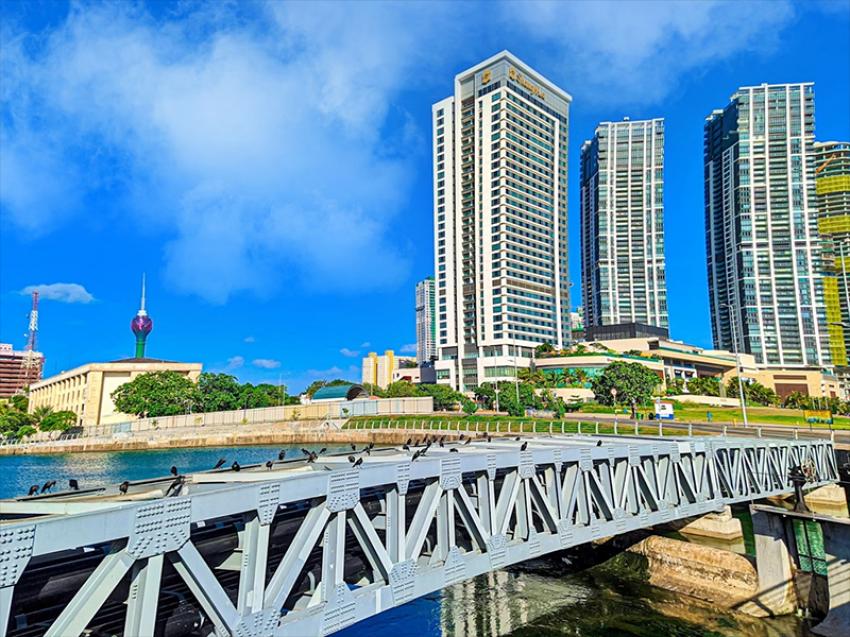 The Colombo skyline. Image credit: Chamindu Perera/Unsplash
The Colombo skyline. Image credit: Chamindu Perera/Unsplash
Endowed with glorious beaches, forests and waterfalls, tea and spice gardens, eight UNESCO World Heritage Sites, food and cultural diversity, adventure tourism opportunities, Sri Lanka has something for travellers of every interest.
Not surprising though. After all, it is this emerald island, once known as Serendib, which was instrumental in adding a new word—serendipity—to the English language.
The nearly 40 minute drive from Bandaranaike International Airport to capital Colombo—the most convenient base to start a Sri Lanka trip—was smooth and comfortable.
As we neared the city limits, it was impossible to miss the Colombo Lotus Tower, an architectural and technological marvel, which symbolised the resurrection of a nation burdened by political and economic turmoil in the recent past.
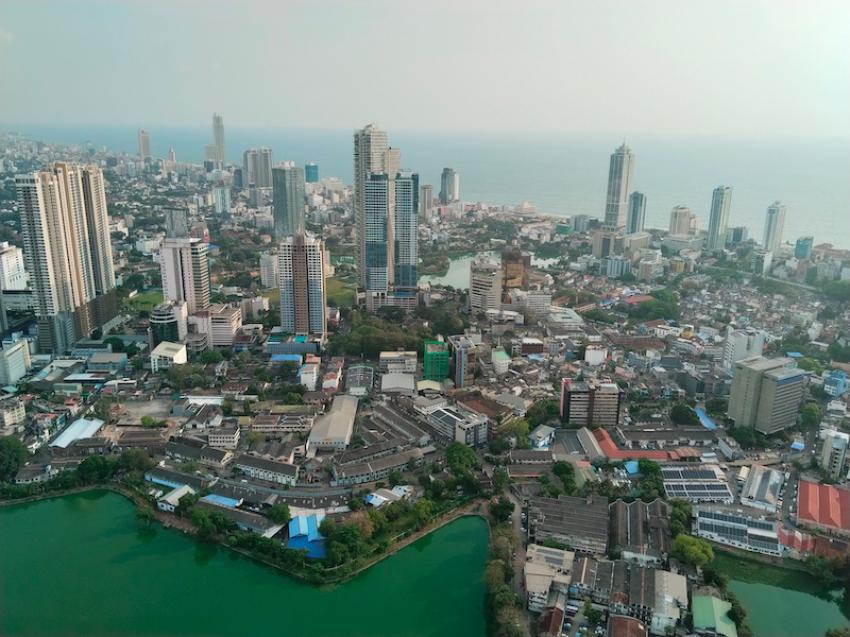 Colombo city as seen from the Observation Deck of the Lotus Tower
Colombo city as seen from the Observation Deck of the Lotus Tower
Said to be South Asia’s tallest self-supported structure and Sri Lanka’s tallest skyscraper, the tower (356 meters/1168 feet) looks mesmerising at night when illuminated in myriad hues, and includes an observation deck (29th floor) offering a panoramic view of the city, a revolving restaurant, a digital museum called Pixel Bloom (ground floor), among other things.
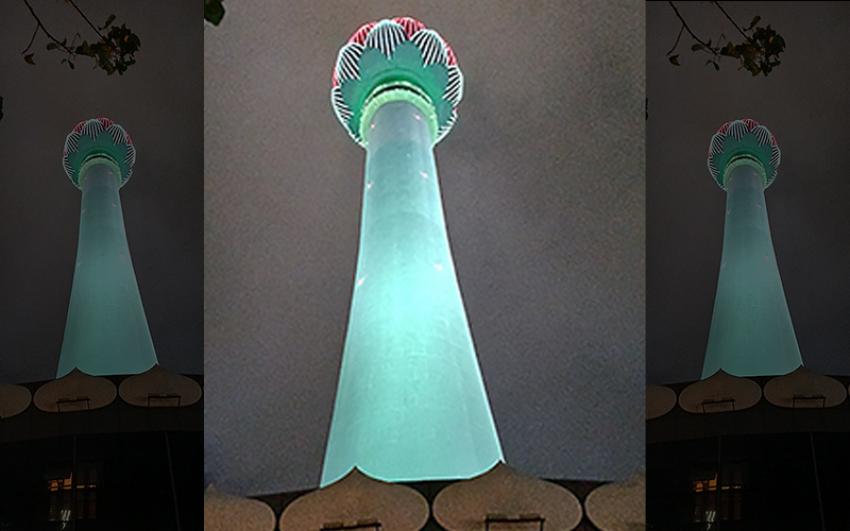 Colombo Lotus Tower at night
Colombo Lotus Tower at night
Soon, we drew up at the luxurious five star property, Cinnamon Life, which was part of the gigantic City of Dreams, hailed as the country’s first integrated resort and entertainment centre, and further proof that Sri Lanka is focussing on attracting global travellers, especially the millennials or younger.
But that does not mean the island nation has severed its link with the past.
Polonnaruwa
Our tour of the hinterland began with a journey to Polonnaruwa, which was inscribed a UNESCO World Heritage Site in 1982, the same year that the popular English music band Duran Duran shot three music videos in Polonnaruwa and other popular attractions in Sri Lanka.
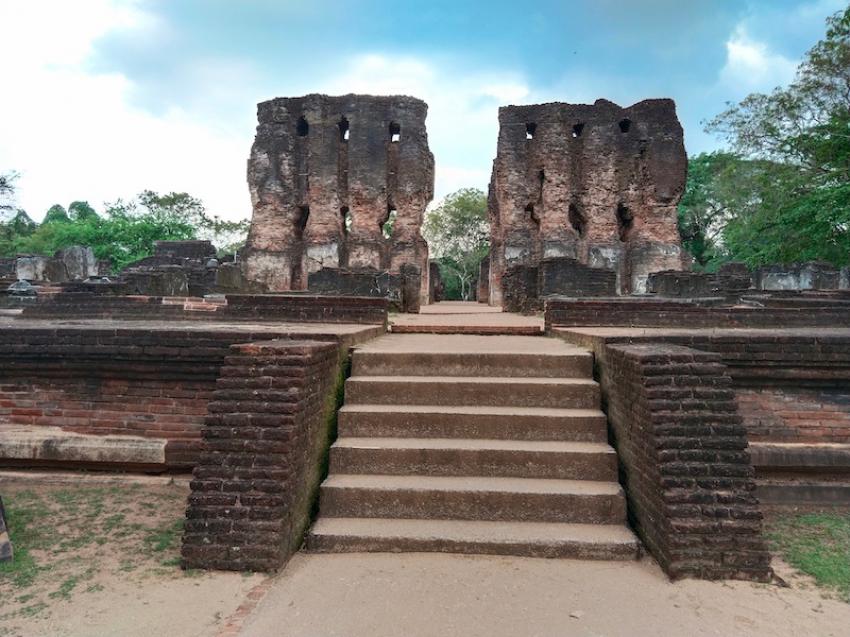 Ruins of the palace built by King Parakramabahu, Polonnaruwa
Ruins of the palace built by King Parakramabahu, Polonnaruwa
A visit to the Archaeological Museum had prepped us about the history of Polonnaruwa, which became the second capital (11th to 13th century) of the country after the destruction of Anuradhapura in 993 AD.
It was the invading Chola rulers from the southern part of India who converted a military outpost to establish their capital at Polonnaruwa, which was recaptured by the Sinhala ruler Vijayabahu I.
Vijayabahu and his able successors, Parakramabahu and Nissankamalla, largely contributed to the architectural splendour of Polonnaruwa.
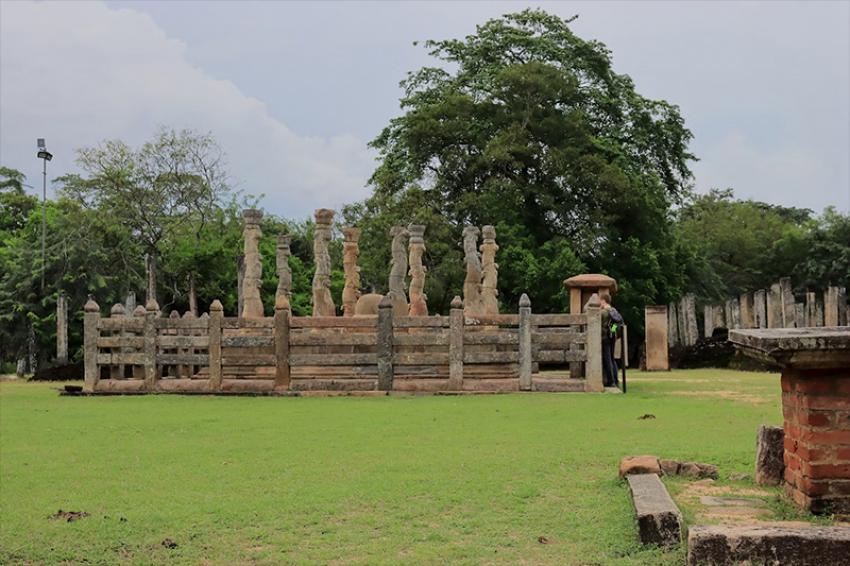 Nissankalata Mandapa, Polonnaruwa. Image credit: Rathna Deepaya/Unsplash
Nissankalata Mandapa, Polonnaruwa. Image credit: Rathna Deepaya/Unsplash
Some of the outstanding ruins included three stories of the once seven-storied Vijayanta Prasad built by Parakrambahu, surrounded by ruins of other buildings which were probably used for rituals and entertainment apart from residences of palace staff; the king’s bathing pond, council chambers, Hindu shrines built by Chola rulers, and Buddhist structures unique to Sri Lanka (especially the Vatadage).
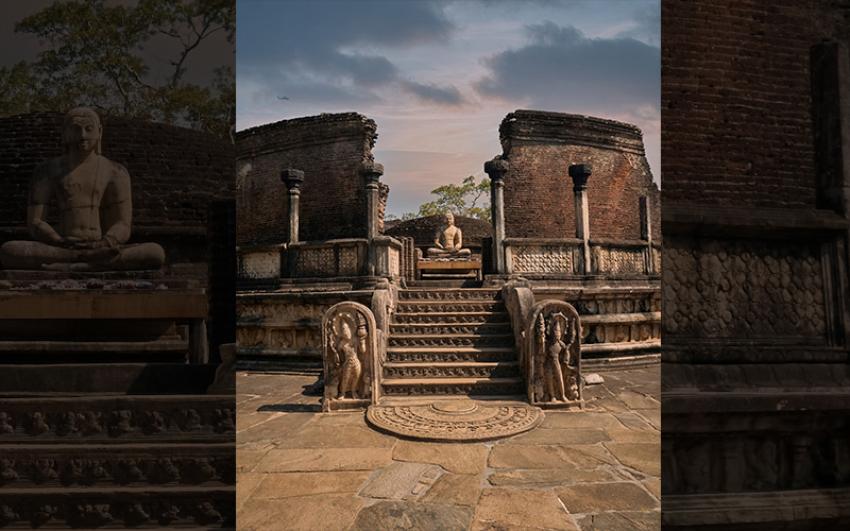 At Polonnaruwa. Photo credit: Birendra Padmaperuma/Unsplash
At Polonnaruwa. Photo credit: Birendra Padmaperuma/Unsplash
The ruins, lying within a landscaped parkland, were fairly scattered, and the walking around had made us tired and thirsty, and a King Coconut break was in order. With an orange-coloured shell, the variety is unique to Sri Lanka and its slightly sweet water is an excellent thirst quencher.
A short drive took us to Galviharaya, a 12th century rock temple, built by Parakramabahu, where Buddha statues in three different postures—standing, sitting and reclining—have been carved on the side of a single granite rock, and marked a departure from the style of art practised at Anuradhapura.
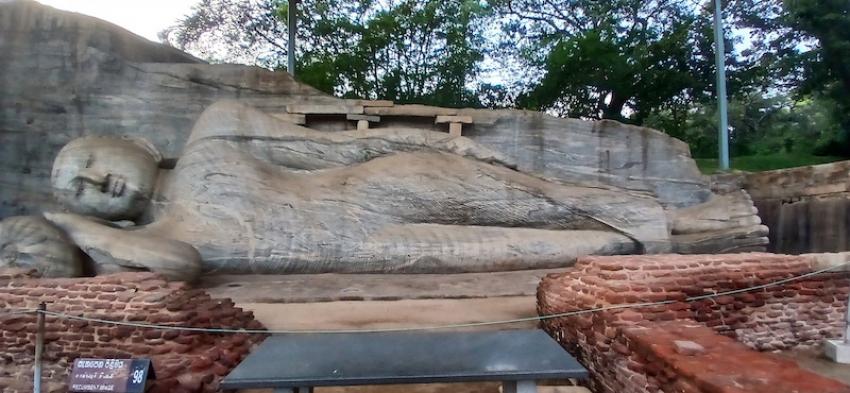 Reclining Buddha at the Galaviharaya, Polonnaruwa
Reclining Buddha at the Galaviharaya, Polonnaruwa
Habarana
The long drive from Colombo to Polonnaruwa (a little over 200km), the lessons in history and architecture, combined with the summer heat, had sapped our energy, and Cinnamon Lodge, Habarana, acted as the perfect remedy to our tired mind and body.
The five star resort was smothered in greenery, with paved paths leading to the luxuriously appointed rooms scattered throughout the complex, which exuded a colonial charm blended with local architecture, and their buffet spread was amazing.
Habarana, about 180km by road from Colombo, sits in the middle of Sri Lanka’s Cultural Triangle (Anuradhapura, Polonnaruwa and Kandy) and is also a convenient base to explore the rock fortress of Sigiriya, the cave temples of Dambulla, and the national parks of Kaudulla and Minneriya (especially known for the gathering of wild Asian elephants in summer).
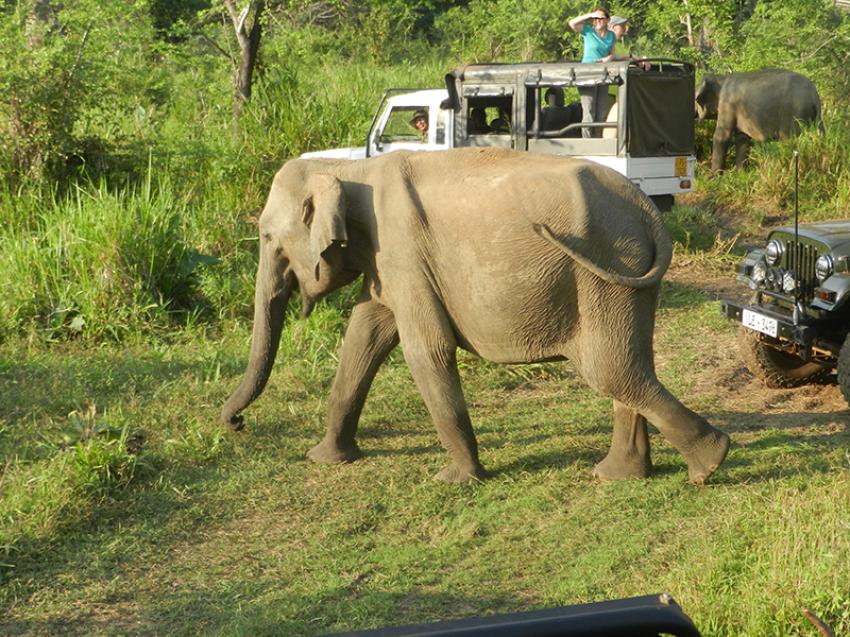 Hurulu shelters elephant herds in summer
Hurulu shelters elephant herds in summer
The following day, we headed to Dambulla, about 20km by road from Habarana, known for its cave monastery—the Rangiri Dambulla Cave Temple—which dates back to the third century BC when it was the abode of forest dwelling Buddhist monks.
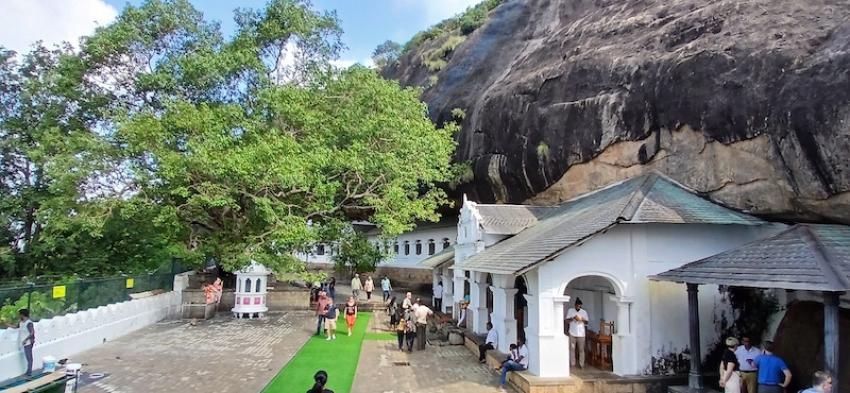 The Dambulla Cave Temple complex
The Dambulla Cave Temple complex
A gentle climb from the car park and then a short flight of stairs took us to the cave temple complex—a row of five sanctuaries—which was inscribed as a as a UNESCO World Heritage Site in 1991, and has been a ‘sacred pilgrimage site for 22 centuries’, according to the organisation’s website.
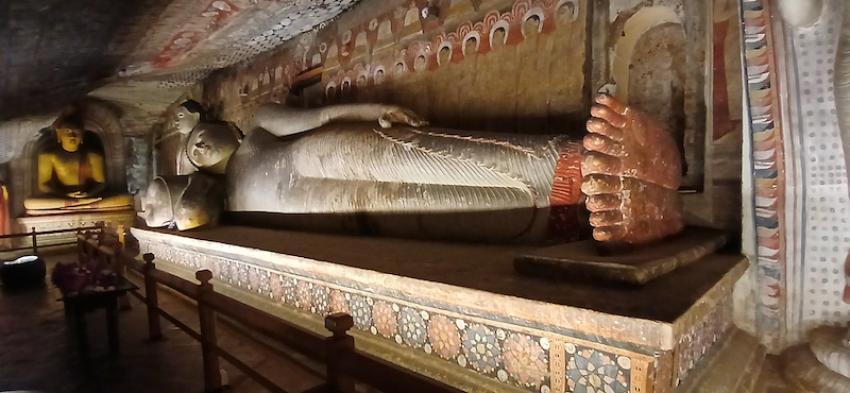 Inside one of the caves in Dambulla
Inside one of the caves in Dambulla
Renovated over a period of time, until the 18th century, often patronised by the royal dynasties, the caves contain an amazing collection of murals and delicately carved statues, an exceptional expression of Buddhist art and sculpture.
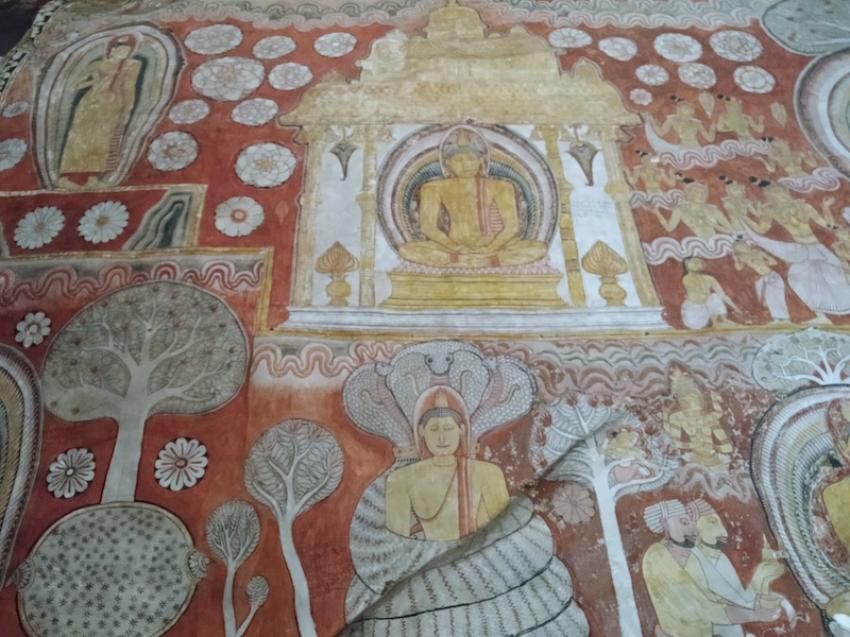 Murals inside one of the caves in Dambulla
Murals inside one of the caves in Dambulla
Apart from statues of Buddha and Bodhisattvas, there are also statues of Hindu gods and Sri Lankan rulers.
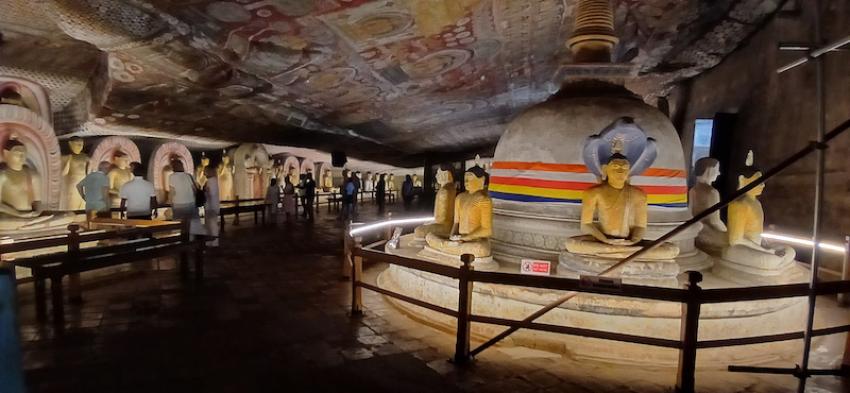 The cave temples in Dambulla have interesting layouts
The cave temples in Dambulla have interesting layouts
In the afternoon, after a delicious meal of Kottu Roti (a popular Sri Lankan street food consisting of shredded roti, vegetables and chicken) at the dainty village restaurant named Dewata Villa’s, we headed for a wildlife safari at the Hurulu Eco Park.
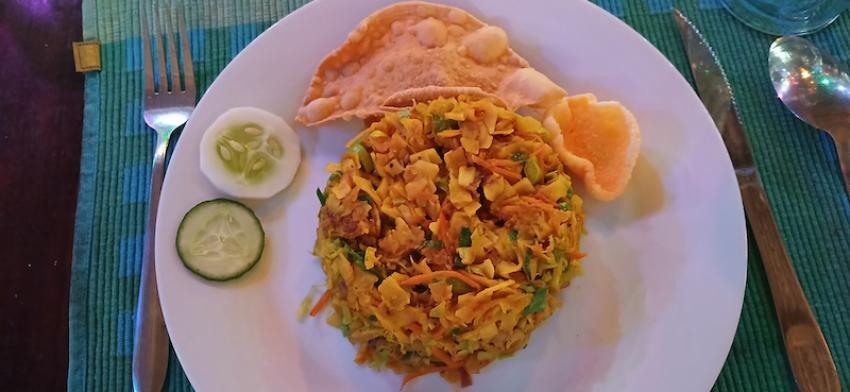 Kottu Roti is a favourite Sri Lankan street food
Kottu Roti is a favourite Sri Lankan street food
Despite the hot afternoon, there were a large number of vehicles inside the park, often jostling for space to catch the best view of the elephant groups.
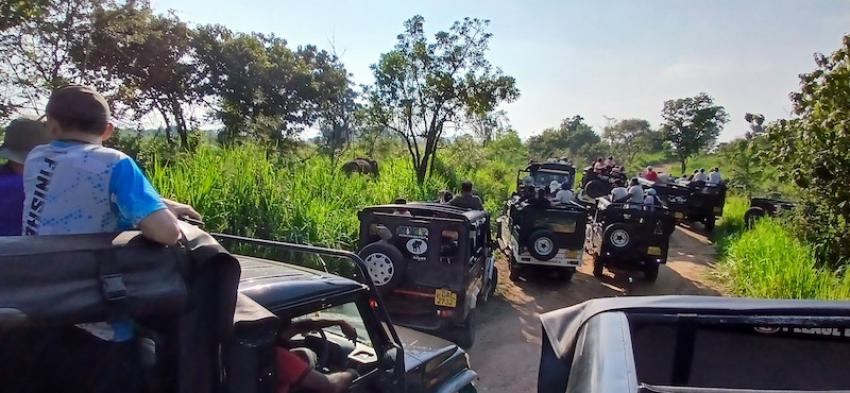 Safari vehicles jostle for a view of the elephant herds in Hurulu Eco Park
Safari vehicles jostle for a view of the elephant herds in Hurulu Eco Park
However, the human crowd was not a deterrent for the pachyderms, adult and young, who roamed freely, foraging in the grassland.
.jpg)
Wild elephants at Hurulu Eco Park
Next day, we rose before the sun, and drove to the base of the Pidurangala Rock (about 14km away); the hike to the top starts on a fairly easy note but gets difficult gradually, especially towards the end, when you have to scramble over rocks and boulders.
Some of the boulders have ropes attached to help the climbers while at some you are on your own. Although fellow travellers often lend a helping hand, it is best to be accompanied by a local guide.
The flat top of the rock, perched at nearly 200 meter above sea level, offers a 360 degree view of the surrounding forest and the famous Sigiriya Rock fortress (a UNESCO World Heritage Site) in the distance, bathed in the golden glow of the rising sun, and is a favourite with photographers and visual content creators.
The Sigiriya village, with its budget hotels and homestays, appeared to be popular with backpackers, and offered various activities, such as adventure sports, village tours, and meals at a local home (often with lessons in local cuisine).
At the edge of Hiriwadunna Lake, a man-made reservoir, we boarded a country boat that would take us on a slow ride across the water to the eponymous village for a home cooked lunch.
Around us the forest unfolded along the banks, sometimes within reach, sometimes far away.
.jpg)
Boat ride at the Hiriwadunna Lake
Although it was almost noon and the sun was strong, we did catch glimpses of a few cormorants and pelicans in the lake.
As most of us had left our hats behind, our boatman, a deft craftsman, wove us caps from water-lily pads, and necklaces from the stems.
By the time we reached the home of our hostess Shyamali Ratnayake, she had the ingredients laid out and the clay oven with its wood fire burning, and ready for the culinary demonstration before serving lunch.
Being from India, I would frequently realise the similarities with Sri Lankan lifestyle, a reflection of the long relationship shared through historical times, which was once again evident here—with our lunch consisting of rice, fried fish, dhal, curries made from fresh vegetables, chicken and meat, prepared with spices, such as turmeric, cinnamon, cumin, coconut milk, etc., and served on a leaf platter.
After a sumptuous lunch, and demonstrations of traditional methods of rice pounding, leaf craft, etc. we walked back from the village to the lakeside where our vehicle awaited us.
Haputale
The days were getting hotter and we were yearning for the cooler climes. So it was time to visit the central highlands, known for its lush green hills and tea gardens.
Travelling past the fringe of Minneriya National Park, we caught site of a lone jumbo standing by the wayside; as we got too excited and opened the door of the vehicle for a better shot, it mock charged at us, reminding us who makes the rules here.
We made a brief stop at the Matale Aluviharaya (Aluvihare Rock Temple), whose history goes back to the third century BC, and among other things is said to be the place where oral Buddhist scriptures were transcribed in Pali; bypassed the town of Kandy; soon the car was ascending the winding mountain road.
Lunch was at the scenic Ramboda Falls Hotel, down a steep gradient opposite the famous Ramboda Tunnel, said to be the country’s longest road tunnel—an artistic impression of which features on the front side of the Sri Lankan rupees one thousand note.
The restaurant overlooked the waterfalls and the surrounding hills while a flight of stairs led to the bottom of the cascade.
As the car climbed higher and higher, we could see acres of tea gardens rolling down the slopes.
.jpg)
Tea garden on way to Nuwara Eliya
Just like in India, it was the British rulers who introduced tea growing in Sri Lanka, and the first estate was launched in 1867; while the brew, with its body and flavour influenced by the local weather and soil, among other things, is popularly known as Ceylon Tea the world over, the Sri Lanka Tea Board owns the Ceylon Tea lion logo, which is the mark of genuine and quality Sri Lanka tea.
.jpg)
At the Damro Tea Estate
We drew up at the Damro Labookellie tea centre sitting in the middle of tea gardens sprawling across the slopes, and were taken on a free tour of the tea factory located here.
We were served an array of tea produced here, which we sampled along with some delicious tea cakes (the tea comes free but the cakes have to be paid for).
With a stop at a roadside strawberry shop and a quick drive through Nuwara Eliya—which still preserves glimpses of its British past—we arrived at the Melheim Resort & Spa, a boutique hotel on the outskirts of Haputale town, in pouring rain.
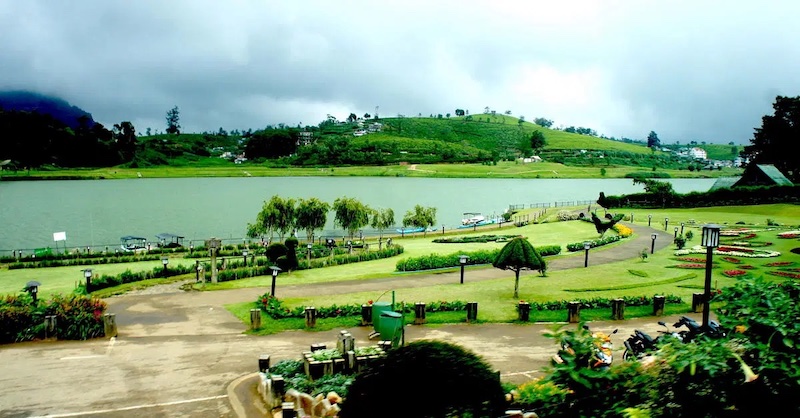
Nuwara Eliya Gregory Lake. Photo: Sujoy Dhar
The luxuriously appointed rooms with balconies were staggered along the hill slope and offered a panoramic view of the surrounding verdant mountains but what we loved best was the scenic deck where we would have our meals, share our breakfast with visiting birds.
Our last stop in Haputale was at the Diyaluma Waterfalls, about 35 km away by road from town, and then a trek through forested hill slopes.
.jpg)
The upper Diyaluma waterfalls. Image credit: Lakshan Mamalgaha/Unsplash
En route we stopped at a bridge from where we could see the entire cascade (220 meter/720 feet), the second highest waterfall in Sri Lanka.
There are several routes—easy to moderately difficult—leading to the top of the waterfalls, and we chose the one by the Ka Sun hotel, where the first stretch consists of a flight of stairs before entering a narrow forested ridge past the ticket counter for the Upper Diyaluma falls.
.jpg)
A rock pool created by the cascade on way to Upper Diyaluma
The waterfalls come down the hills in several stages, forming quaint pools on the way, especially some very instagram-worthy pools at the top.
Galle
Another long road journey (a little over 200km) from Haputale and we were at our final destination on the itinerary.
.jpg)
Galle is known for its Indian Ocean views
The famous seaside town of Galle, which is known for its Portuguese (16th century) and Dutch (18th century) legacy, welcomed us with mesmerising views of the Indian Ocean, its blue colour reflecting the cloud free sky.
The Old Town of Galle and its Fortifications were inscribed as a UNESCO World Heritage Site in 1988, and according to the global body, it serves as ‘the best representation of a fortified city built by the Europeans in South Asia, showing the interaction between European planning principles and South Asian architectural traditions’.
.jpg)
Fort Wall, Galle
From the inshore Galle Lighthouse located on the ramparts of the fort, we walked up to the main fort, enjoying a walk over the fort walls and the courtyards, guided by the signage dotting the precincts.
.jpg)
Many of the old buildings in the fort area have been preserved
If you are not historically inclined, a visit to the Old Dutch Hospital complex is a must—the building now renovated to a shopping and dining haven; if you have more time in hand, take a walk along the narrow cobbled streets, full of small shops and eateries.
Our final hours in Sri Lanka were spent at the Galle sea front, where we looked upon the ocean washing up the sandy beach, and scores of water sports enthusiasts surfing the gentle waves.
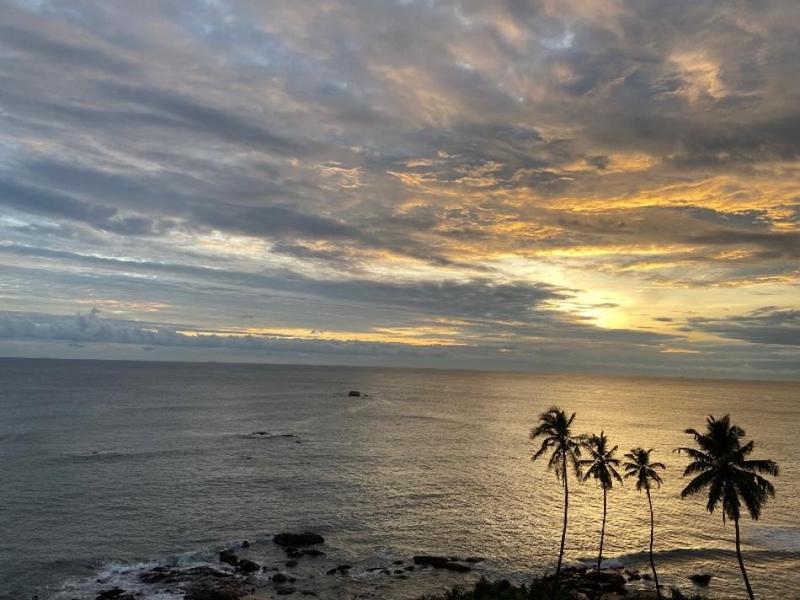
A Galle sunset. Photo: Sujoy Dhar
As we sipped on Ceylon tea at a small shack by the beach, we watched the sun going down, its orange hue embossing the water and sky with a delicate play of colours.
Late in the night, we drove back to Colombo airport for the flight back home on the morrow.
Photo courtesy: Unsplash / Uttara Gandopadhyay / Sujoy Dhar

Uttara Gangopadhyay is a Kolkata-based travel writer. The author represented India Blooms News Service and Not In Town (IBNS / www.indiablooms.com and www.notintown.net) at the launch of the global campaign titled ‘Sri Lanka, A Story for Every Season’, undertaken by the Sri Lanka Tourism Promotion Bureau. For any tourism promotion collaboration write to us on: sujoydhar@gmail.com
- From kebabs to biriyani: Lucknow gets UNESCO honour for its royal cuisine
- Delta takes Spanish flavours to the skies
- Kolkata’s iconic Kathi Roll among world’s top 10 wraps: TasteAtlas
- Yellow Taxis and the Colours of Puja
- Starbucks introduces special Durga Puja inspired menu for Kolkata, with an attractive discount offer too
- Rosé All Day and Coastal Vibes: Dining at Chicago's The Hampton Social – River North
- A taste of South India this Durga Puja at Garden Café in Kolkata
- Ireland promotes culinary tourism in Germany with new food campaign
- Karim’s Entally launches heritage menu reviving old Calcutta flavours
- Sleepless in Budapest
Starting Nov 16, 2025, IndiGo will operate direct flights between Bengaluru and Riyadh, expanding its network to Saudi Arabia.
American Airlines will launch new seasonal service between New York (JFK) and Edinburgh, Scotland (EDI) in March 2026, expanding its international network.
Emirates will celebrate Diwali, the Hindu festival of lights, by offering special meals and entertainment on its flights to and from India between Oct 17 and 24, the airline said.

